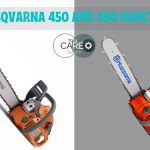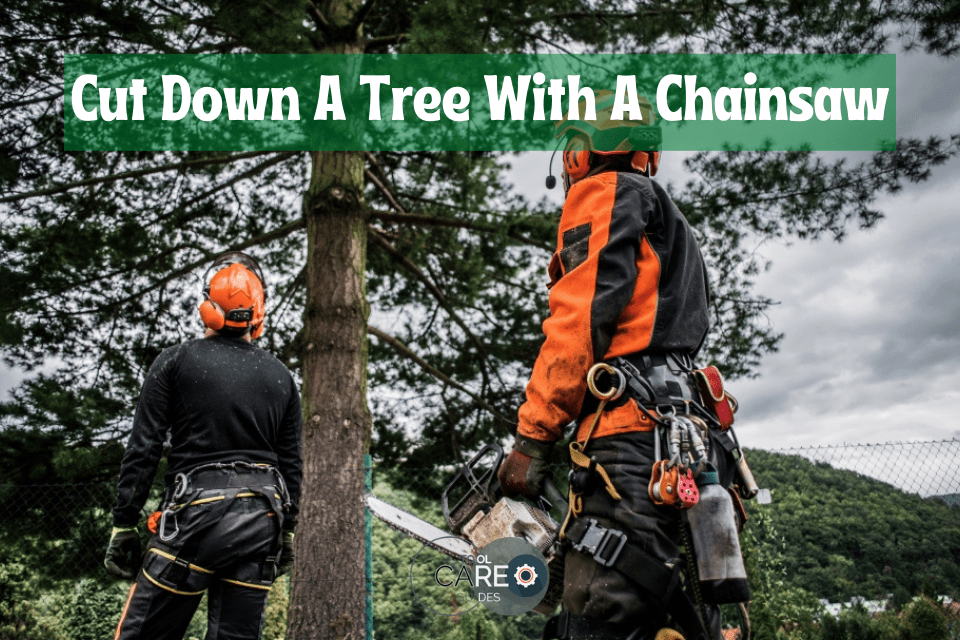Quick Overview of This Article
Did you know that every day approximately 2.47 million trees are cut down? While the trees are vital in making various products, they can easily cause injuries if the felling process is done casually. In this regard, knowing how to fall a tree safely is vital.
Do you have a tree that needs to be cut? If yes, this guide on how to fell a tree with a chainsaw is for you. Though trees are beneficial, the need to cut them down sometimes outweighs that of keeping them. For instance, the tree may be diseased, rotting, or may be dangerous to your home or the neighborhood. Regardless of the reason, you need to know how to fall the tree safely.
There are numerous ways you can use to cut down trees. However, in this article, we shall focus on how to cut down a tree with a chainsaw.
In most cases, most people tend to go for professionals as they consider it the right decision. They urge that cutting down a tree requires professional skills, planning as it can be hazardous, especially if the tree in question is significant, in a hard place or the site location has issues.
However, suppose you feel the actual size and its location is something you can ideally handle? In that case, all that you need is to have an experience with your chainsaw, sober, fit, alert, sensible, and lastly, perfectly prepared for the work.
If you feel like you have any doubts, experts advise that you should not even dare.
A chainsaw is a fast and efficient method of felling down or cutting down a tree. However, there are several factors that you should always put into consideration before and during the cutting process.
Some of these factors are;
Check The Surrounding Of The Tree You Intend To Fall.
Try to work out the correct height and the clearance area for at least the same meters in the distance as the tree. In case there is an object, such as a fence, a greenhouse, garden furniture, statue, or washing line, you have to remove them at least for the time being for that tree to fall safely. If it’s in a woodland area, you should think about what will happen to the other trees surrounding the one you intend to cut.
Decide On The Exact Location The Tree Will Fall After You Finish Cutting.
Ensure that the area is clear at a reasonable distance. Permeably, ensure the radius that removes the tree is several meters extra than the tree’s height.
Take An Angle Behind The Tree
When it comes to the escape path, ensure it’s atleast at a 45-degree angle to the back of that tree. Clear everything surrounding that tree and ensure that no children, pets, or anyone other than you get closer to that area for their safety.
Ensure Chainsaw Is Well Charged And Fueled
It is vital to ensure that your chainsaw is entirely and well-charged or fueled, well sharpened and that all its safety features are working and functional.
Make Sure You Have The Appropriate Clothing.
Ensure you have safety equipment like a helmet and significantly when cutting the tree down under all circumstances. Ear defenders are also crucial with the safety glasses for eye protection, heavy-duty and good quality protective gloves, steel-toed shoes or better still boots for leg protection, heavy-duty cloths, and chainsaw proof.
Make The First Cut Horizontally.
It will help if you cut it at around hip height, determining your Wedge and Notch cut. Remember that it should at no point be more than a third of the tree’s width.
Your Next Step is the Wedge and Notch cut.
The cut should be at the back of the horizontal cut at a 45-degree angle, leaving the wedge-shaped hole. Ensure the cuts meet.
Make a Slightly Higher Cut
Since the back cut will be from the rear of the tree, opposite the other cuts, ensure you make a slightly higher cut than the previous one.
Ensure you create enough room for slipping the wedge in. drive the wedge, then continue cutting without touching that wedge. Ensure you don’t cut right through. And finally, when the tree starts falling, move carefully using your escape route to a safer area.
Once done with all this, you can then start limbing a tree and bucking them. This method works best as an alternative to moving the tree for firewood for those using firewood to fuel a wood-burning stove.
How To Cut Down A Small Tree With A Chainsaw
As a casual chainsaw user, you need to understand some basic rules when cutting down small trees. However, before that, you need to understand that the chainsaw plays a considerable role in the felling process. Therefore, you need to understand how to choose the right chainsaw for your work.
Choose the Right Chainsaw to Cut Down a Tree
While choosing the chainsaw for your felling job, you should consider the following factors:
- The chainsaw’s power: This depends on the size of the tree you intend to cut. If the tree is medium or large-sized, a gas-powered chainsaw is the most effective saw to use. You can also select a battery-powered chainsaw, but that depends on its battery power.
- Type of Chainsaw: As outlined, gas-powered chainsaws are ideal for medium or large trees since they have more torque. You should mainly use electric chainsaws at home since you must connect the power cord to a power source. The battery saw can be used outdoor only if the battery is powerful enough to last hours.
- The Saw Operator: Gas-powered chainsaws are mostly ideal for men who are strong enough to handle its power. Women and aged people should select an electric chainsaw since it’s lightweight and easy to use at home.
- Bar Length: The size of the chainsaw’s bars are measured in inches. You should consider getting a chainsaw with at least a 16-inch guide bar for felling trees.
- Chainsaw’s Safety Features: Chainsaws can easily cause accidents if not handled safely. However, recent saws are fitted with safety features such as anti-kickback and LowVib technology. While choosing the chainsaw to use, select the one with these kinds of safety features.
- Condition of the Chainsaw: Before embarking on felling trees, ensure that the saw is in the best working conditions. The saw should be clean, oil-free, and the chain should be sharp enough to cut down trees. If you are using a gas-powered chainsaw, ensure that you have a full fuel and chain oil tank. Likewise, ensure that the battery of a battery-powered chainsaw is fully charged and in good condition before you start cutting any tree.
These rules include:
1. Personal Protection.
Ensure your body is not fatigued when going to use the chain saw. Also, remember to have protective wear and safety equipment for your eyes, face, head, ears, legs, and ankles.
2. Check The Safety Of The Chain Saw
Ensure the following items are working well:
- Chain brake
- The Throttle lock
- The Spark muffler
- The condition of the saw
3. Check the Surrounding
• Be keen on overhead hazards
• Ensure you remove the tripping hazards
• Clear the space you intend to work on, any bush, loose branches, or spring poles
• Have an escape route
4. Tree Felling Considerations
You alos need to factor in the following considerations:
- The need for professional services for tree felling
- Which direction will the tree fall?
- The side and back lean in regards to the direction you target the tree to fall.
- The area where the tree will fall so that you can avoid it
5. The Stump Plan
Consider the following in your stump plan:
- The face cut will determine which direction the tree will fall. Therefore, align the face cut with your target direction.
- Determine the hinge dimensions; the hinge length should be 80% of the diameter at the breast height (dbh) of 4.5′ from the base, the hinge thickness should be 10% of dbh.
- Slightly start the back cut above the bottom cut line.
- Do not saw through the cutting hinge.
- Confirm if there are any hazards around you and your team before releasing the tree.
- The tree whose dbh is twice the length of the chainsaw bar would be the best felt through a technique that is called plunge cut. It is an advanced technique and should only use after first going for proper training.
How to Cut Down a Tree with Electric Chainsaw
Electric chainsaw can be defined as a mighty machine for felling. If not well handled and with proper checking, it can lead to injuries and even deaths in some cases.
When ready to do cut your tree, it is always good to consider the safety procedures involved. This is to make sure you will be safe when you are cutting the tree and those around you.
The following are some safety tips on cutting down a tree with an electric chainsaw from a Chainsaw Safety Expert.
1. Which direction do you want the tree to fall?
It is imperative to note that when the tree you are cutting falls, it can fall on objects surrounding it, such as the electric lines, nearby trees, or even a house.
It is always good to let it fall in a natural direction if there is no obstructive object on that side. When deciding, consider if the area it falls in is easily accessible for a more straightforward removal process after felling the tree.
2. Escape Route
Anything can happen in the process of cutting the tree, therefore requiring you to step back or retreat from the mission. Before you start cutting that tree, ensure all the debris, loose limbs, branches, and anything surrounding the tree is gotten ridden off. This move is to make sure that nothing will hinder you if you want to escape, hence making yourself safer.
3. Clearing Prop Roots and the Limbs
Support or props roots are those connected to your desired tree. More so, there are branches located at the lower tree trunk, making it difficult to cut the tree. Before cutting the tree, use the chainsaw to cut them off.
Ensure you clear them from the upper side using the downward stroke method. Additionally, cut down the limbs through the chainsaw’s lower edge and ensure that the trunk is between you and the electric chainsaw.
Once you decide the direction the tree will fall and all the surroundings are clear, make the necessary cuts (directional notches) that will trigger the tree to fall in your chosen direction.
Directional notches determine where and how the tree will go down. For example, open directional notches are for cutting medium or small-sized trees.
4. Locate A Landmark That Can Act As Your Guide
The tree’s environment will have a landmark or object that can assist you in clearly locating which direction you want the tree you are cutting to fall. Additionally, utilize the sights on the chainsaw to determine the angles of the directional notches you intend to use.
5. Create The Directional Notch
Start by making a top cut into the tree trunk ranging from 20-25 degrees of the tree’s diameter at an angle of 60 degrees. Next, start cutting from the bottom of the trunk so that the parallel cut joins the cut you made previously. This method creates a curved out directional notch that faces your desired location.
6. Check If There Are Any Persons or Animals Passing By
To ensure safety for all, check if anyone is passing by or any animal around the felling area. This should exceed the total length of the tree you intend to cut by two times.
7. Creating the Felling Hinge
Saw a horizontal felling cut a few inches above the undercut level on the opposite side of the trunk to create a hinge on which the tree will fall in a measured way. To make the hinge effective, ensure it is 10% of the tree trunk diameter. A lever will make the tree with the hinge start falling. While cutting trees, felling wedges are used as levers.
8. Move Back to a Safe Distance
To avoid injuries, always create a distance between the falling tree and yourself. While moving away, be alert so that in case the tree falls in another direction, you can quickly avoid it. Also, avoid being close to the felling area or the area where the tree trunk de-attaches from its base.
Ask for experts’ help and guidelines whenever you wish to cut down more giant trees. However, if you have to do it yourself, make a plunge cut, i.e., directional notches on both sides since the tree’s diameter is greater than the chainsaw’s bar length.
Further, if by any chance the chain saw bar is stuck into the trunk, instead of pulling it out, switch off the engine and then use the wedge to work on the tree trunk up to the point you will be in a position to remove the chainsaw with ease. You can also use the hammer for putting wedging in place so that the tree can start falling.
Wrapping Up
Remember that when winds are strong, they can make the tree fall in a different direction from what you anticipated. If there is any object towards where the tree will fall, you can always seek help from professionals that deal with tree removals.
Have basic safety rules, which you can get through a chainsaw safety class. Also, ensure you have the correct type of chainsaw you need depending on the work.
In addition to that, always remember that your safety should always come first. Secondly, ensure you have the correct chainsaw for the tree you intend to cut, and lastly, don’t forget your escape route at all times.
Having learnt how to cut down a tree with a Chainsaw in this article, you can apply the techniques and tips on your tree felling project. Always remember to keep safe.




